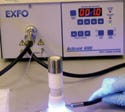November 2, 2005
Originally Published MPMN November 2005
PROFILE
Improved Bonds Lead to Clear Signals for Surgical Equipment
A UV-cure system is key to achieving the precise, repeatable assembly of a device designed to unblock arteries.
|
UV-cure systems developed by Exfo Precision Assembly Group ensure repeatability by embedding sensors and electronic controls within the lamps. |
To remove plaque buildup in arteries, percutaneous transluminal coronary angioplasty (PTCA) is a less-invasive alternative to traditional coronary artery bypass grafting (CABG) procedures. PTCA eliminates major surgery by inserting a guidewire into the artery. It requires less recovery time and is far less costly to the patient and the medical facility than CABG. The success of this technique, however, depends on doctors being able to see the guidewire’s path as it travels in the artery and through the blockage. Optical coherence reflectometry (OCR), developed by IntraLuminal Therapeutics Inc. (Carlsbad, CA; www.intraluminal.com), uses a combination of radio-frequency (RF) technology and mirrored fiber optics to allow the doctor to see the boundary of the vessel, thus avoiding touching the artery wall with the wire. To work properly, the system’s fixtures must be precisely aligned and bonded. Finding a suitable method to bond the components proved to be a challenge for IntraLuminal.
IntraLuminal’s Safe-Cross system enables interventional cardiologists and endovascular surgeons to cross and recanalize totally occluded arteries. It provides real-time feedback of the proximity of the crossing wire to the arterial wall. Radio-frequency power at the tip of the wire assists in penetrating hardened material, allowing the safe passage and placement of therapeutic devices such as drug-eluting stents.
“The cardiologist is able to pull back and redirect the wire,” explains senior production manager Tara Piantoni. “The light generates a reflection that is recombined to deliver a signal predicting the path ahead of the tip of the guidewire. It shows the physician that he or she is within the arterial wall. This is one of the major challenges in crossing blockages,” she adds.
Building Strong Bonds
Production of the proprietary guidewire system is intricate and done manually. “The fixtures must be aligned precisely,” says manufacturing manager Diego Cueto. “Then we set adhesive and UV cure it for a specific amount of time. We needed to bond a mirror to the end of a fiber-optic [device] to increase the signal to the reference box, and we began having problems. We were running into bonding issues that were reducing the amplitude of our signal and also distorting the signal that we were getting,” he explains.
Cueto turned to Exfo Precision Assembly Group (Mississauga, ON, Canada; www.exfo-uv.com), a company that specializes in UV-cure systems with proprietary controls specifically designed for complicated medical applications.
After testing the application, it was discovered that the problem stemmed from a fluctuation of the irradiance, or power, of the cure dose delivered to the part. This is a common issue with older UV spot-curing systems. As bulbs degrade, the cure dose fluctuates. Without a method to maintain a steady and repeatable dose, users typically need to continually test the lamps and manually adjust them.
The Exfo cure system offered slightly higher power than the previous system. More importantly, it has aperture control. Once the output is set, the cure dose is repeatable. This does not affect the steady voltage flow to the lamp and offers a much wider adjustment range. By incorporating closed-loop feedback, a mechanical iris automatically adjusts as the power of the lamp declines. A beam splitter in the optical path coupled to electronics controls this process.
“We were continually using a meter to measure the power of our previous system,” says Cueto. “We had to keep finding our threshold point and guess if it was time to change the bulb. The new system is more conducive to manufacturing. It adapts the power and sounds alarms if the bulb needs replacement,” he explains.
Jeff Scullion, applications development manager for Exfo, explains that a key to getting a full cure when delivering energy to dissimilar substrates is understanding that parts absorb heat differently and expand at different rates. Cure depth depends on the wavelengths of the light used, the absorption properties of the adhesive material, and the thickness of the bond. Systems with embedded software allow different cure profiles to be set via a PC. Creating multistep curing profiles can help minimize shrinkage and ensure alignment between components throughout the curing process.
Under- or overcuring always affects the integrity of the final product. Therefore, it’s important to prioritize process control and repeatability. Spot-cure systems that incorporate closed-loop feedback control, whether manual or automated, and an integrated radiometer or intensity monitor allow the system to make necessary adjustments that will compensate for lamp degradation.
Exfo ensures consistent repeatability by embedding sensors and electronic controls within the lamps to optimize performance and monitor lamp hours. “For medical device processing, particularly in the area of invasive devices, control of the cure process is imperative,” notes Scullion.
Bottom-Line Benefits
In the year and a half since IntraLuminal began using the new curing process, the firm has seen its production reject rate drop from 60% to zero. “We just didn’t know what the problem was,” says Cueto. “We were throwing things at the bond, adding materials to protect the bond . . . beefing it up without knowing the solution was in the process, not the material. Now our bond cure is 100%.”
Copyright ©2005 Medical Product Manufacturing News
You May Also Like



